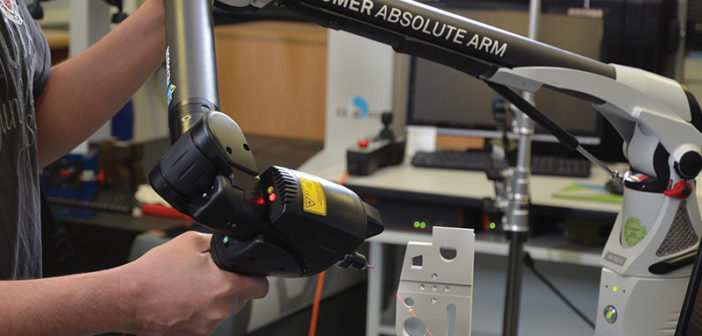What is your name and position within Hexagon Manufacturing Intelligence?
David Demiter, Engineering Manager for Portable Arm CMMs in Oceanside, California.

As a child, I used to frustrate my parents by taking things apart to see how they worked. I once nearly started a fire in the garage by trying to plug 110 Volts from a wall outlet into the metal frame of a toy car! This type of curiosity stayed with me, and influenced my decision to study Electrical Engineering at UCSD. After graduating, I did electronic design for cameras, imaging systems, and machine vision. For several years, I was in the role of an electronics engineer, then I became team leader for an applications engineering team. With four years in that role, I transitioned to becoming an engineering manager. I joined Hexagon Manufacturing Intelligence as an engineering manager in November of 2015.
What does your day to day look like at Hexagon Manufacturing Intelligence?
At the factory here in Oceanside, engineering has continuous interaction with production, purchasing, quality, service, and manufacturing. Our discussions revolve around any support that is required from engineering, or improvements that can be made. In addition to discussions within this factory, almost every day brings interaction with our colleagues in Montoire, France, who co-produce the measuring arm. These discussions vary from new R&D projects, to lifecycle activities of our current product offering. My role is to manage and coordinate engineering resources to keep things running efficiently and smoothly.
What are your future goals?
The immediate goal I have for myself and for the team is to generate new product ideas. Hexagon is already an industry leader in the world of metrology, so it is even more important that the team here in Oceanside focus on truly noveland unconventional ideas. When the earliest version of measuring arms was introduced, there was nothing like it in the marketplace. We are looking for emerging technologies, or ideas to try that have never been done, and that fulfil a needin industry. Our goal is to bring something to the marketplace that has the same potential as the arm did in the early days.
What feature of the ROMER Absolute Arm do you find to be the most beneficial to advanced manufacturers today?
The ROMER Absolute Arm is truly robust. This instrument is used in environments from clean rooms to the dirtiest of shop floors, and everywhere in between. Our customers benefit from being able to turn on themachine, and start measuring immediately. They also benefit from being able to switch probes without recalibrating each time. RDS (the software interface to the arm), gives users the flexibility to choose application software that fits best with their application. Another big benefit comes from synergies between products within the Hexagon product portfolio.
What major changes do you see impacting the portable CMM industry in the next five years?
For most users of the ROMER Absolute Arm, the accuracy is very good or exceeds their needs. While we can, and should work in improvements to accuracy, I think the biggest push in innovation within the portable CMM industry will be to improve productivity. Manufacturers live in a world of global competition, where they are continuously pushing to become more efficient, and lean. Having measurement equipment that can save a minute or two per inspection, means a lot. Hexagon is a leader in this area with features like repeatable probe mounting, fast, high-resolution laser scanning that tops our competitors.
Another key area is data analytics. This isn’t only an interest area for portableCMM users, but for anyone using metrology equipment. A customer might use the arm to measure production parts, but has no insight into trends or patterns. He finds himself asking “What were the measurements like six months ago when we ran this same part? How do measurements vary from lot to lot? Which machine produces the best parts?”. Data from the arm might already be there, but without a tool to do some statistical computation, he is limited to learning about individual parts. Statistical analysis will continue to play a larger and larger role for all manufacturers. The addition of Q-DAS to the Hexagon portfolio gives our customers the ability to analyze their data and make key decisions and improvements.
What do you do for fun outside of working at Hexagon Manufacturing Intelligence?
I have three young children that keep my wife and I very busy! We have boy / girl twins that are 8 years old, and a 10-year-old girl. We participate in the YMCA Indian Guides program where we go camping once a month with the girls, and once a month with the boys. I also love going to the skate park to skate the pools with my son.
What is something that most people don’t know about you?
We are amazingly blessed in this country. Most of us take our next meal, or the clothes on our back for granted. My wife and I make it a point to give liberally to those less fortunate, and to teach our kids to do the same. We enjoy driving into Mexico with the kids to distribute clothes, and blankets. This coming fall I will be working on a project to put a roof on a church / communitycenter down in Tijuana.














